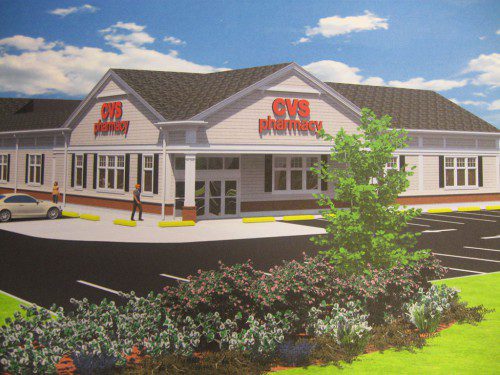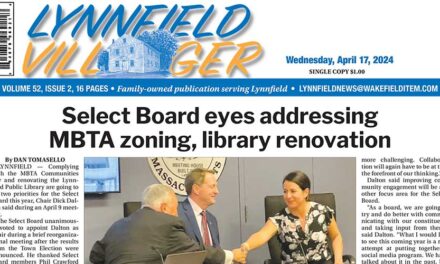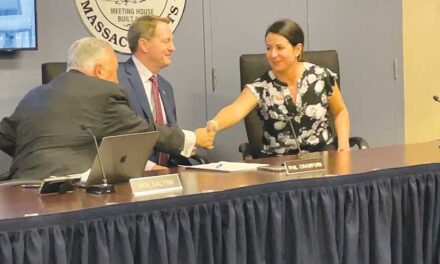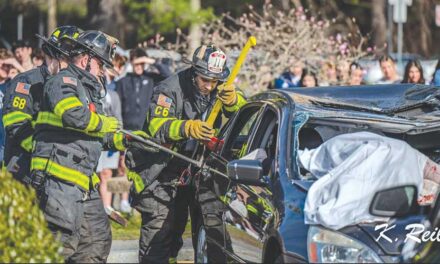Published in the September 23, 2015 edition

THE ARCHITECTURAL rendering of the redesigned free-standing CVS Pharmacy building proposed for the corner of Salem Street and Broadway incorporates traditional colonial features to blend into the abutting residential area on Salem Street. (Maureen Doherty Photo)
By MAUREEN DOHERTY
LYNNFIELD —The citizens’ petition seeking to rezone a portion of the Bridgewell property from Residence A to Limited Business will go forward without the support of the Planning Board.
After listening to the presentation by the proponents representing Bridgewell and CVS, which seeks to build a free-standing CVS Pharmacy on the site, along with comments from the public during last Thursday’s two-hour public hearing, the Planning Board voted 4-0 with one member absent not to recommend passage of the warrant article at Fall Town Meeting on Oct. 19.
Voting against recommending the zoning change were Planning Board Chairman John Faria and members Alan Dresios, Charles Wills and Heather Sievers. Member Randall Crompton was absent.
None of the 10 residents who spoke at the hearing were in favor of the proposal despite the efforts of CVS to redesign both the building and the lot layout based on input gathered by the design team during three informational public meetings that Bridgewell and CVS hosted for the neighbors in February and June.
Revisions included eliminating the drive-thru pharmacy window, reducing the footprint by about 1,100 square feet, restricting truck delivery access and egress to Route 1 only and incorporating traditional Colonial style architecture, materials and colors into the building facade, such as clapboards, window shutters and roof shingles to better blend in with the residential neighborhood.
Group home to remain
The citizens’ petition, which required the certified signatures of at least 10 registered Lynnfield voters to get onto the warrant, seeks to rezone about four-tenths of an acre of property (17,523 square feet) at 834 Salem St. (Rte. 129).
Bridgewell owns three pieces of adjoining property at the intersection of Broadway (Route 1) and Salem Street (Route 129) totaling 78,551 square feet that fall into two different zoning districts, Limited Business (LB) and Residence A.
The largest of the three parcels (39,417 sq. ft.) is occupied by a large brick office building that currently houses the company’s corporate headquarters and has frontage on both Broadway and Salem Street.
The northern corner of the site contains the smallest parcel (6,599 sq. ft.), currently occupied by a small home converted into office space for Bridgewell with frontage only on Broadway. Both parcels are currently zoned LB and both buildings would be razed under the proposed plan to make room for the CVS building, parking lot and access and egress onto the site.
Bridgewell’s third parcel at 834 Salem St. is 32,535 sq. ft. in area and is currently located entirely in the Residence A (RA) district. It is occupied by a single family home, which Bridgewell operates as a group home for women. The company intends to continue operating it as a group home even after the adjoining property is sold.
This group home parcel currently shares a 273-foot deep lot line extending from Salem Street northerly to the rear lot lines of residential homes on Munroe Street. This lot line is the existing dividing line between the two zoning districts. Munroe Street falls within the RA district, as does an adjacent home on 505 Broadway.
Under the Bridgewell proposal, 834 Salem St. would be split into two zoning districts in order to add 17,523 sq. ft. of area to the LB district.
The group home would remain in the RA district and utilize the remaining 15,012 sq. ft. of area with 130 feet of frontage at 834 Salem St. to conform to the district’s zoning requirements for a single family residence, which requires a minimum of 110 feet, according to Brian Dundon of RJ O’Connell and Associates.
Driveway access to the group home would not be from Salem Street. The driveway access would remain at the rear of the home, with a connection into the CVS lot running parallel to the homes on Munroe Street and the adjacent RA lot at 842 Salem St., the location of a single family home utilized as office space for the Lynnfield Water District.
If the rezoning request succeeds, the combined area of the enlarged LB lot occupied by CVS would total 63,539 sq. ft. (1.46 acres) with 71 parking spaces, most of which face the corner of Routes 1 and 129.
The shape of the rezoned Salem Street parcels resemble the states of Vermont and New Hampshire, with the “Vermont” pork chop portion becoming the LB zone. This configuration would add about 24-feet of LB frontage on Salem Street and provide landscaping between the group home and the two-way access-egress on the CVS lot.
The triangular LB pork chop gradually widens out as it approaches the nearest corner of the CVS building about 80 feet off Salem Street. It incorporates additional landscaping along the entire length of the CVS building plus a rear triangular portion of the proposed 11,870 sq. ft. single-story building with a 1,661 sq. ft. mezzanine.
The rezoned portion of the parcel would also provide two-way driveway circulation around the building plus additional landscaping, five parking spaces and a screened enclosure for the side-by-side Dumpster and trash compactor located between CVS and the group home, in addition to the driveway access to the group home.
The nearest point of the CVS building to the residentially zoned lot at 505 Broadway would be less than 34 feet. The Dumpster/trash compactor enclosure is about 20 feet from the rear of a residential home on Munroe Street.
Planning Board reaction
While the Planning Board was impressed by the thoroughness of the presentation put together by the CVS/Bridgewell team of lawyers, engineers and real estate developers, the members noted since this is a zoning change that would permanently alter the use of this parcel of land, the fact that CVS was the applicant seeking this change and had made various promises to the neighborhood had no effect on the question posed to the board as to whether such a change would be beneficial to the town.
“In reality, it has nothing to do with CVS. It is all circumstantial,” Dresios said, citing as an example promises being made that truck traffic would have its access and egress limited to Route 1 rather than Salem Street.
“After rezoning, anything can go into that area. It doesn’t have to be CVS,” Dresios said, explaining that as long as the use falls under the accepted uses listed under section 4.2 of the town’s zoning bylaw, it could be built there.
Faria agreed. “I don’t think it matters whether it’s CVS or ABC, whatever we recommend today may end up being in perpetuity. If this goes forward, it affects the town forever,” Faria said.
Dresios said he considers rezoning nearly 18,000 square feet of land from a residential use to a business use a “significant area” equivalent to about “100 parking spaces.” He was especially concerned with the traffic impact to the entire area by such a zoning change, not just the effect of the change in the use of the property from a professional office setting to a retail store.
Dresios said when he was a selectman 10 years ago he initiated a traffic study of this entire area, including Goodwin’s Circle and the jug handle on Rte. 1. Solving this area’s traffic woes “involves Peabody, Danvers and Lynnfield and the three towns have to come together. Unfortunately, they should have been working for the past 10 years on this and they haven’t,” Dresios said.
Dresios believes by rezoning this parcel the applicant gains the value of that 18,000 square feet of land while the town gets nothing in return “to help us out with our problems” because the intersection at Broadway and Salem Street will continue to function at a “Level of Service F,” he said. He added if the applicant had offered the town about 2,000 sq. ft. of land “to provide a right turn lane on the highway, maybe that would have an impact,” he said, and improve the service level and safety of the area.
Sievers agreed that the traffic at this intersection is dangerous and believes it would not be improved by recommending this zoning change. “I did try to commute that way for awhile. It is very stressful,” she said, adding she has since changed her route. “I personally will go to great lengths to avoid this intersection and I just can’t see adding anything else to it,” she said.
Recalling the incredibly high piles of snow from last winter, Sievers said she feared for the “safety of the kids” who would be “walking down the middle of the street” in this area toward the Salem Street intersection to meet their school buses. She also did not not like the shape of remaining portion of the residential lot at 834 Salem St. that would be carved out to make this change possible.
Faria said he has considered the other possible uses that could be built on this site under the town’s existing zoning, such as doughnut shops, fast food establishments or convenience food marts. Since the lot is currently small, he said the corresponding sizes of such potential uses would also be on a smaller scale.
“If this CVS does not make it financially, they will quickly sell,” Faria said, and if that were to occur, having a larger lot would mean the replacement shops would also be larger, he said.
“That side of town is under tremendous pressure,” Faria said, adding that he did not see “any benefit” to the town in recommending this zoning change.




